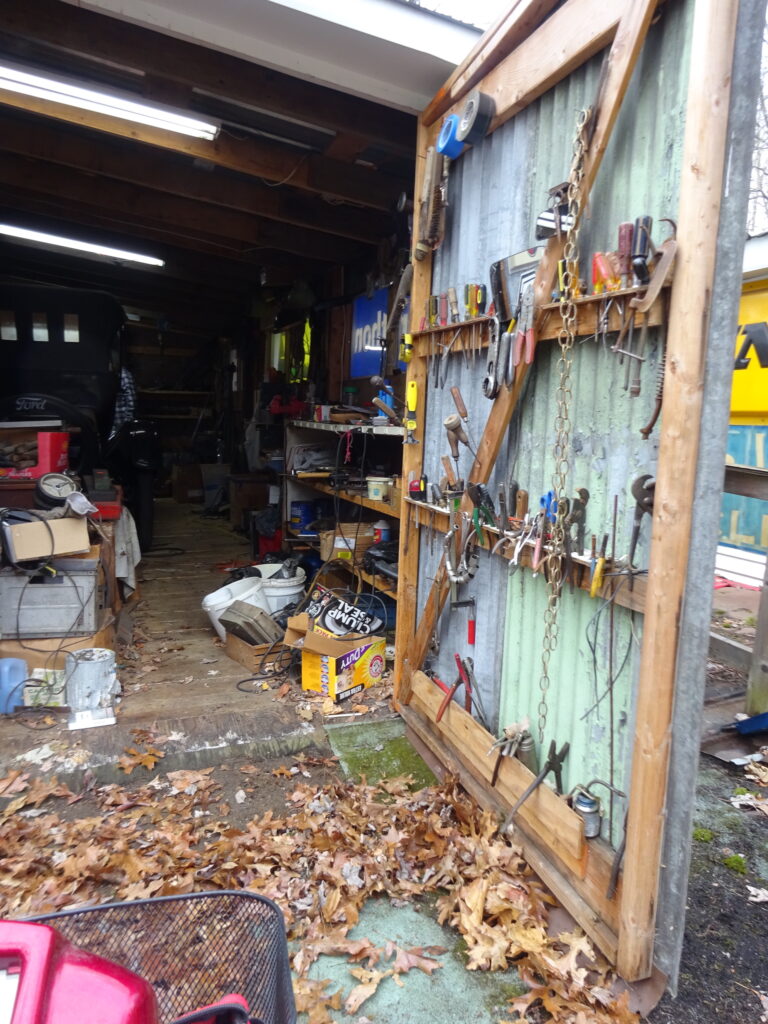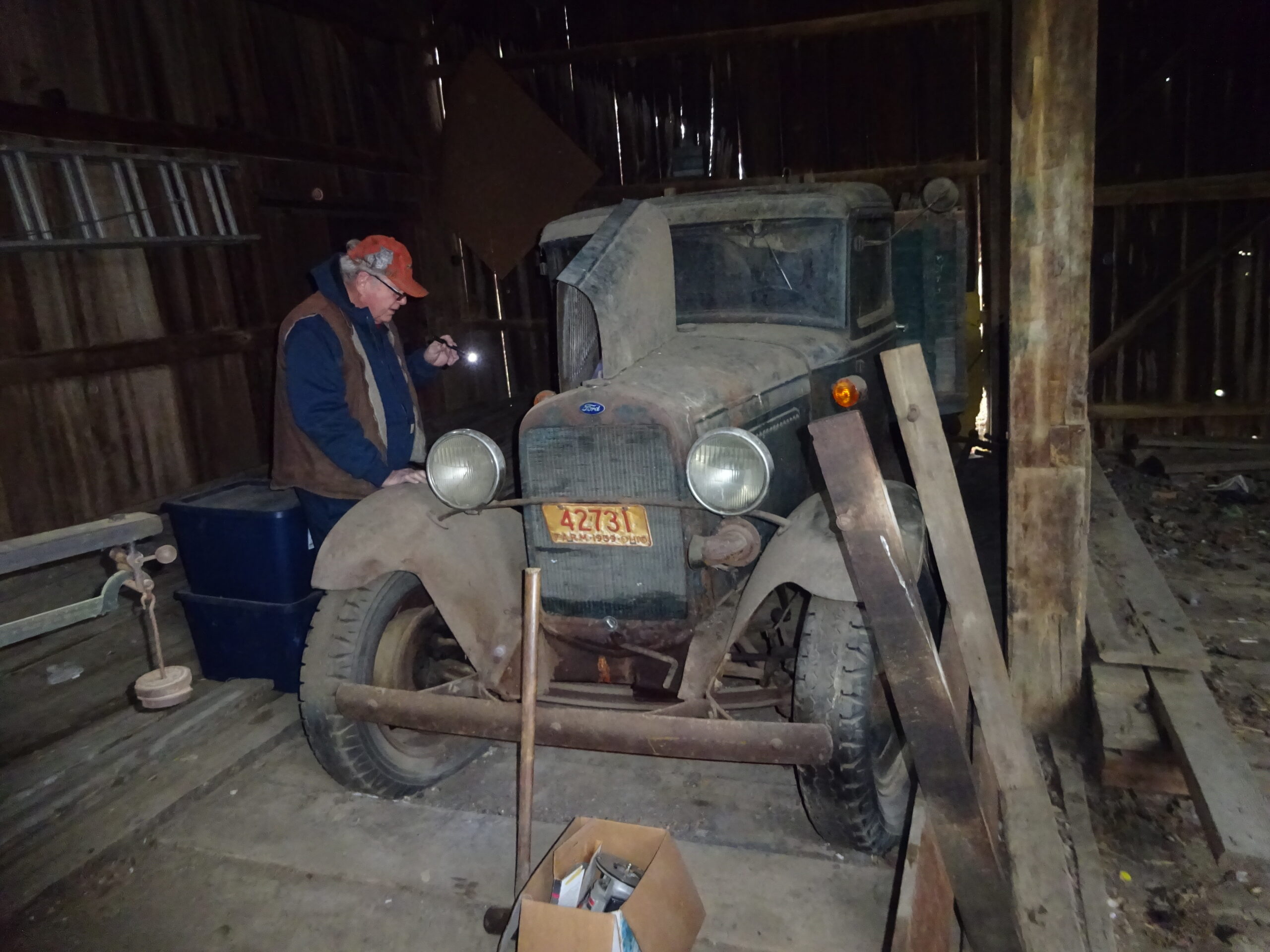This is part three of the story about running down a Model “A” Ford lead and purchasing the car. Jerry and I most often look for hobby cars that were never finished or cars that have sat in the garage for years and years, forgotten until a new owner or relative comes on the scene and wants to clean things up. Some of our adventures honestly turn out to be quite peculiar. This one did not disappoint as we discovered a virtual homestead of Bizarre Disneyworld. We came to this place in search of a Model “A” Ford that might be for sale. The last time we discovered something like this—at a collector’s or more correctly, hoarder’s place–the cars were so far rusted and gone that we didn’t even make a bid for either of them. That seller was psychiatrically impaired and very out of touch with reality. His caretakers were reluctant to challenge his grasp on things. This time, however, the caretakers were much more rational, normal people. The car of interest turned out to be a 1928 Model “A”AR(very early production) Ford Phaeton open car, a very desirable car in anybody’s book. It was somewhat apart, but mostly all there and in a dry garage. It looked as if someone had possibly rebuilt the engine and was beginning to reassemble things. Then it was suddenly left as it was when last touched, wrenches askew as if things came to a halt in the middle of a conversation 2 months ago, 2 years ago, or 16 years ago.
The actual condition of the car was better than we expected. The paint was acceptable and possibly original, the upholstery was certainly not impeccable but not ripped up either. The engine was obviously being worked on with wrenches and tools on the engine head. The distributor was all apart and broken. The wiring was torn off and in a ball, and the radiator, fan and light bar were off and leaning on a wall beside the car. One headlight was missing. It was standing on 4 semi-inflated tires. We couldn’t turn the engine over. The early 1928s (known as ARs—I don’t know why) had an unusual clutch–either the clutch or the engine could be frozen up.

We surveyed the garage that the car was in and tried to inventory exactly what was lacking, and what was present. The floorboards were out but leaning against the wall. The mechanical brakes were not hooked up—no brake rods. The radiator, headlights and bar, and front bumper were off the car and leaning against the wall. The engine and various components of the engine were newly painted—possibly overhauled? We wouldn’t know that until we actually got it into our shop. Because the engine was frozen up and the car disassembled to a good degree, we were very leery of the car and so only put in a bid to buy it as a pile of parts—the worst case scenario. The next day the fellow called me to say that they would accept the bid. The car had a title—important in Ohio.
How do we get this car out of this bizarre barnyard with substantial trees about, piles of junk everywhere, and then up a 30 degree grade, narrow alleyway to the main highway. It was a true obstacle course. We had to do this with haste before the snow descended upon us. Mentor is in the snowbelt in Ohio. My Toyota Tundra extended cab truck and hydraulic tilt car hauler are rather massive vehicles even on the highway. The truck is 4-wheel drive! This narrow alleyway concerned me greatly though the caretaker assured me that he could get his car hauler through it. I never did see his car hauler so that was not particularly reassuring.
The easy part was winching it onto my car hauler and tying it down. We loaded up the truck bed with all the paraphernalia and loose parts, extra tires and wheels. It was piled to the top of the cap! We did NOT want to make a second trip down to, through, and back up this maze. I figured the whole works would weigh in at say 9 tons—the Toyota is a substantial truck. Upon trying to pull away from the shed I had to jockey back and forth many times with Jerry out front or back signaling come back 4 inches, cut it to the max to the right etc., etc., etc. Finally we got it out of the maze and up to the alleyway.
My truck and trailer rig are 8 feet wide. The alleyway, filled with hanging bottles, junk, paraphernalia on either sides was no more than 9 feet wide. I put it in 4 wheel drive and started up the incline. On several occasions I reached out and touched, grabbed the bottles, my mirrors only inches from snagging one of them. It was touch and go. At the peak of the hill the engine was racing. Whew! We made it out to the parking area. I don’t want to ever do that again. Whatever is left behind in Bizarreland is going to stay there.
It’s now been two months since we rolled it off the trailer and into Jerry’s garage. Within five days he had gotten the engine unstuck. There was absolutely no oil in the engine what-so-ever. How odd! Had the engine been treated to a spray can rebuild………the outside degreased and painted only? The compression was significantly lower than normal but would be if there was no oil in it at all.
This was the first AR model “A” that either of us had ever worked on. Though we had read about them no one in the club had ever had one. Model “A” production began in October 1927 and they began selling them in December. The first cars, designated as AR cars, were mechanically different than all the later Model “A”s. It is not at all clear when the switchover began or how many AR cars were produced. But it is clear why Ford modified the mechanicals—these early cars were inferior. Of greatest importance, they had a primitive clutch system of cones, the brake system was attached to the transmission housing which could sag and you would lose your brakes, the steering box and column was very different than all the later cars, the brakes were thinner and different. There were a multitude of smaller, less significant differences as well.
As we started to put this car back together we quickly discovered that very few AR replacement parts were available from any of the Model “A” parts catalogs. Those that were offered were priced up to ten times higher than standard Model “A” parts. We consulted with all the good mechanical club members, and called places around the country for advice. The route to go was to eliminate the AR parts and replace them with traditional “A” parts. Except that, this called for some re-engineering to make the parts fit. The brake system had to be reengineered back to standard “A” specifications and independent of the transmission housing. The steering column and box were replaced with later “A” parts, the clutch system replaced with a standard disc clutch. Jerry has a milling machine and a lathe in his shop and spent many hours re-engineering the systems to make them work as they should. Once we put oil into the engine and rewired it properly it started up and ran satisfactorily. It now starts, stops, steers and goes down the road satisfactorily and is a pretty good example of a Model “A” Phaeton.
I ask Jerry, “so will we be buying another early Model “A” AR?” “Not in a million years. Never again!!”
















